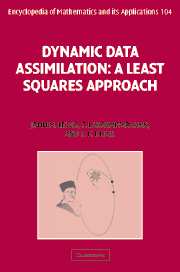Book contents
- Frontmatter
- Contents
- Preface
- Acknowledgements
- PART 1 GENESIS OF DATA ASSIMILATION
- PART II DATA ASSIMILATION: DETERMINISTIC/STATIC MODELS
- PART III COMPUTATIONAL TECHNIQUES
- PART IV STATISTICAL ESTIMATION
- PART V DATA ASSIMILATION: STOCHASTIC/STATIC MODELS
- 18 Data assimilation – static models: concepts and formulation
- 19 Classical algorithms for data assimilation
- 20 3DVAR: a Bayesian formulation
- 21 Spatial digital filters
- PART VI DATA ASSIMILATION: DETERMINISTIC/DYNAMIC MODELS
- PART VII DATA ASSIMILATION: STOCHASTIC/DYNAMIC MODELS
- PART VIII PREDICTABILITY
- Epilogue
- References
- Index
20 - 3DVAR: a Bayesian formulation
from PART V - DATA ASSIMILATION: STOCHASTIC/STATIC MODELS
Published online by Cambridge University Press: 18 December 2009
- Frontmatter
- Contents
- Preface
- Acknowledgements
- PART 1 GENESIS OF DATA ASSIMILATION
- PART II DATA ASSIMILATION: DETERMINISTIC/STATIC MODELS
- PART III COMPUTATIONAL TECHNIQUES
- PART IV STATISTICAL ESTIMATION
- PART V DATA ASSIMILATION: STOCHASTIC/STATIC MODELS
- 18 Data assimilation – static models: concepts and formulation
- 19 Classical algorithms for data assimilation
- 20 3DVAR: a Bayesian formulation
- 21 Spatial digital filters
- PART VI DATA ASSIMILATION: DETERMINISTIC/DYNAMIC MODELS
- PART VII DATA ASSIMILATION: STOCHASTIC/DYNAMIC MODELS
- PART VIII PREDICTABILITY
- Epilogue
- References
- Index
Summary
This chapter develops the solution to the retrieval problem (stated in Chapter 18) using the Bayesian framework and draws heavily from Part III (especially Chapters 16 and 17). The method based on this framework has also come to be known as the three dimensional variational method – 3DVAR for short. This class of methods is becoming the industry standard for use at the operational weather prediction centers around the world (Parrish and Derber (1992), Lorenc (1995), Gauthier et al. (1996), Cohn et al. (1998), Rabier et al. (1998). Andersson et al. (1998)). This global method does not require any form of data selection strategy which local methods depend on.
From the algorithmic perspective, there are two ways of approach for this problem – use of the model space (ℝn) or use of the observation space (ℝm) (refer to Chapter 17). While these two approaches are logically equivalent, there is a computational advantage to model space when n < m, whereas the advantage goes to observation space when n > m.
In Section 20.1, we derive the Bayesian framework for the problem. The straightforward solution for the special case when the forward operator is linear is covered in Section 20.2. The following Section 20.3 brings out the duality between the model space and the observation space formulations using the notion of preconditioning. The general case of nonlinear method is treated in the next two sections with the second-order method in Section 20.4 and the first-order method in Section 20.5. The first-order method for the nonlinear case closely resembles the linear formulation.
- Type
- Chapter
- Information
- Dynamic Data AssimilationA Least Squares Approach, pp. 322 - 339Publisher: Cambridge University PressPrint publication year: 2006



